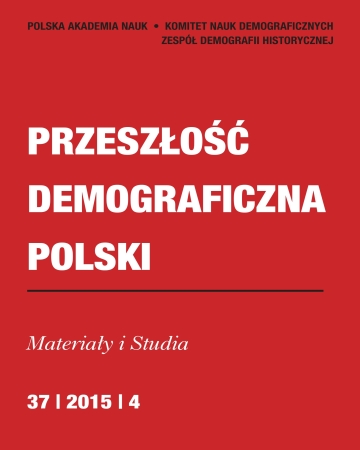Zawieranie małżeństw na przedmieściach Szczecina w świetle akt stanu cywilnego z obwodu USC Gumieńce w latach 1875–1906 Część II. Wiek nupturientów
Contracting Marriages in the Suburbs of Stettin (Szczecin) in the Light of Documents form the Register Office of Scheune in 1875–1906. Part 2. The Age of Bridegrooms and Brides
Author(s): Łukasz KozłowskiSubject(s): History, Social Sciences, Sociology, Social history, History and theory of sociology, Demography and human biology
Published by: Wydawnictwo Naukowe Uniwersytetu Szczecińskiego
Keywords: age; Gumieńce (German: Scheune); marriages; newlyweds; register Office documents; Szczecin (German: Stettin); Western Pomerania
Summary/Abstract: The years 1875–1906 saw an intensive development of the urban complex of Szczecin; the industrial, housing and social infrastructure was rapidly growing, and there wasan inflow of rural population from outside the county of Randow. The socio-economic development in the outskirts of Szczecin was accompanied by significant demographicchanges. The article presents the effects of the accelerated urbanisation and industrialisation of Pomorzany (German: Pommerensdorf) – a suburban district of Szczecin – in comparison to neighbouring towns and villages, where such changes were much less rapid or did not occur at all. That is why on the basis of the documents from the Register Office a list was made; it is a list of 1,357 marriages contracted in the years 1875–1906 in the jurisdiction of the Register Office of Gumieńce (Standesamtbezirk Scheune). Thanks to the aggregative method it was possible to measure annual numbers of marriages, seasonality of marriages and an average age of newlyweds. Within the jurisdiction of the Register Office of Gumieńce, Pomorzany was the district where the growth was the fastest: in the period in question its population quadrupled and the number of dwelling houses increased twofold. An analysis of the marriages contracted in Gumieńce revealed that the inhabitants of that district were the youngest newlyweds in the jurisdiction of the Register Office of Gumieńce and the difference of age between bride and groom was the smallest (2.2 years). The inhabitants of Gumieńce, Mierzyn (Möhringen) and Stobno (Stöven) contracted marriages when they were much older, and the difference of age between bride and groom was bigger (2.8–3.8 years). Also the preferences of the newlyweds depended on their social and professional position. Craftsmen, labourers and their daughters contracted marriages at the youngest age, owners of farms and farmers’ daughters – at the oldest age.
Journal: Przeszłość Demograficzna Polski
- Issue Year: 37/2015
- Issue No: 4
- Page Range: 105-124
- Page Count: 20
- Language: Polish

